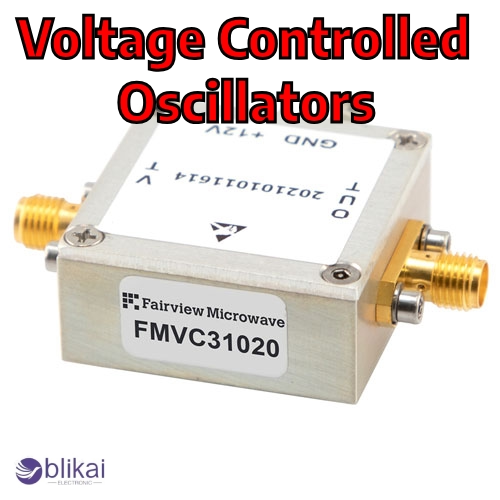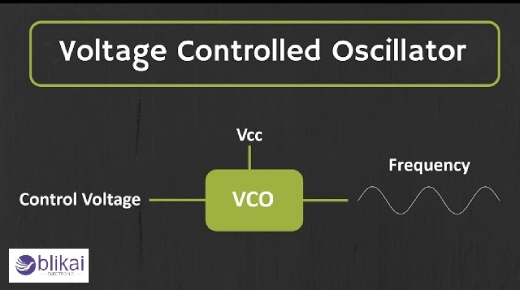Voltage Controlled Oscillator (VCO) Guide: Basics, Types & Applications
You must have wondered about the quality of your radio station transmission during vehicle operations. Your smartphone achieves constant connectivity through what mechanism?

What Is a Voltage Controlled Oscillator (VCO)?
A Voltage Controlled Oscillator (VCO) operates as an electronic generation device that produces oscillating signals through voltage control. The fundamental operation of a VCO entails transforming direct current voltage into alternative current signals with frequency values that relate to the applied voltage amounts.
Key components of a VCO
A VCO consists mainly of three parts which are a voltage-to-current converter, a current-controlled oscillator, as well as a resonant circuit. The input voltage controls a converter device that produces an identical proportional current output. The resulting current enables the oscillator to operate with the resonant circuit for the generation of its output frequency.
How voltage affects oscillation frequency
Inside its operational parameters, the VCO generates frequency changes that correspond linearly with the applied input voltage. When the input voltage improves, the output frequency develops according to direct mathematical proportion. The VCO obtains its voltage-to-frequency conversion from the precise interaction of its components, and the resonant circuit controls both the base frequency and the available tuning range.
Comparison with other oscillator types
Then, VCO provides flexible frequency outputs via its ability to control frequency changes, making it suitable for systems that need either frequency modulation or phase-locked loops. A VCO demonstrates superior tuning capability than crystal oscillators but it delivers inferior frequency precision. A temperature-compensated oscillator demonstrates improved stability performance than traditional VCO yet fails to match their flexibility in frequency control.
Types of Voltage-Controlled Oscillators
LC-tank VCOs
LC-tank VCOs serve the high-frequency applications field because of their remarkable phase noise characteristics. The oscillations in LC-tank VCOs result from the use of a resonant LC circuit. The frequency of oscillation results from the inductor and capacitor values, while a variable capacitor (varactor) under voltage control sets the frequency.
Ring oscillator VCOs
Ring oscillator VCOs consist of an odd number of inverting stages connected in a loop. They are popular in digital circuits and offer a wide tuning range. The oscillation frequency is controlled by adjusting the delay of each stage through voltage variation. While they have lower phase noise performance compared to LC-tank VCOs, they are more compact and easier to integrate into digital systems.
Relaxation oscillator VCOs
Relaxation oscillator VCOs create outputs that go beyond sinusoidal waves because they produce square and triangular waveforms. The device maintains the capacitor at two defined voltage thresholds to perform its operational cycle. The control voltage modifies the charging and discharging operations, which modify the frequency of oscillation. Simple implementation and good linearity characterize these VCOs yet their phase noise performance leans higher than the phase noise capability of LC-tank VCOs.
Crystal-based VCOs
Using quartz crystals in VCOs enables manufacturers to obtain optimized frequency stability together with minimal phase noise output. The crystal delivers accurate reference frequency data which assists the voltage-controlled element in narrow tuning of oscillation frequency. VCOs function ideally in applications that need exacting frequency accuracy combined with stability requirements.
MEMS-based VCOs
Voltage-controlled oscillators built using MEMS technology integrate semiconductor-made miniature mechanical resonators. The oscillators demonstrate superb performance by combining small-scale dimensions with low power needs and stable operation frequencies. The market acceptance of MEMS-based VCOs continues to grow because these devices meet high-frequency requirements and portable design needs.
Applications of Voltage-Controlled Oscillators
A. Frequency synthesis in communication systems
The electrical signal entering VCOs controls their output frequency operation in communication systems. PLL technology uses VCOs as key elements to create precise and stable frequency output for diverse applications. The generation of transmitter carrier signals and receiver local oscillator signals in wireless communication systems depends on VCOs (Voltage Controlled Oscillators). Frequency hopping with channel selection technologies functions efficiently in contemporary cellular and Wi-Fi systems because of VCOs.
B. Clock generation in digital circuits
Digital circuits widely use VCOs as components for generating clock signals. Systems require VCOs to provide timing signals that control different elements' synchronization. Both microprocessors, along with digital ICs, incorporate VCOs within on-chip PLLs to create high-frequency clock signals from lower-frequency inputs.
C. FM modulation in radio transmitters
VCOs function as the essential components that enable modulation operations in FM radio transmitter devices. The control voltage of the VCO receives its modulation from the audio signal, which makes the VCO's output frequency change proportionally to the audio's amplitude. The modulated frequency variations serving as the main carrier for FM broadcasts provide detailed audio transmission space while defending against signal noise interference.
D. Radar and electronic warfare systems
The functionality of radar systems depends heavily on VCOs because they both create the transmitter signal and supply local frequencies to receivers. The rapid frequency agility made possible by VCOs helps electronic warfare systems perform rapid frequency changes for detection avoidance as well as jamming countermeasures.
E. Test and measurement equipment
Test and measurement instruments heavily depend on VCOs for their operation within this field. VCOs are essential components for signal generators as well as spectrum analyzers and network analyzers which use them to create signals at various frequency bands. The precise and broad frequency control capability of VCO proves essential for RF component characterization together with communication system testing and analysis of high-speed digital signal integrity.

Design Considerations for Voltage-Controlled Oscillators
A. Selecting the appropriate VCO topology
A Voltage Controlled Oscillator requires an appropriate choice of topology during design to achieve optimal performance results. The choice of VCO requires examination of operating frequencies alongside power needs along with necessary signal quality specifications. The selection of an LC-tank VCO or ring oscillator depends on specific frequency application demands, size requirements, and phase noise requirements. The best technology for ultra-low phase noise performance remains crystal oscillators but it limits the achievable tuning range.
B. Noise reduction techniques
Minimizing noise is essential for VCO performance. Implement power supply filtering to reduce supply noise coupling. Use high-Q components in LC-tank VCOs to improve phase noise. For ring oscillators, consider differential designs to reject common-mode noise. Employ careful routing techniques to isolate sensitive RF paths from digital signals.
C. Temperature compensation methods
Temperature fluctuations in the system environment negatively impact the operating frequency stability of VCOs. Add temperature compensation circuits that blend either varactor with networks or thermistors linked to bias circuits. The most stable frequency performance can be achieved with temperature-compensated crystal oscillators (TCXOs) alongside oven-controlled crystal oscillators (OCXOs).
D. Layout and shielding best practices
The performance of VCO requires adequate layout design and shielding. Apply a ground plane as it decreases parasitic inductances while offering a reliable low-impedance return path. RF shielding components should be installed to block electromagnetic interference. Digital noise must be kept away from analog-sensitive components. The most critical RF paths should have short, direct routing to prevent signal losses, thus preserving integrity.
Factors to Consider When Choosing Voltage-Controlled Oscillators
Frequency Range
The initial factor to think about when selecting a VCO is its available frequency range. The VCO needs to function across the bandwidth necessary for your system needs. Voltage Controlled Oscillators come with two basic designs which deliver wide tuning capabilities and targeted bandwidth operation.
Tuning Sensitivity
The tuning sensitivity, or gain, of a VCO is crucial. It determines how much the output frequency changes in response to voltage variations. Higher sensitivity allows for finer frequency control but may also make the VCO more susceptible to noise.
Phase Noise Performance
Phase noise serves as a vital specification in all communication systems. The system achieves superior performance when phase noise operates at lower levels. Check the phase noise specifications across the offset frequencies that align with your application needs.
Output Power and Harmonics
Measure the generated VCO power output together with harmonic components in its output signal. Check that both the output power strengths match your system specifications while harmonic frequency output remains within standard limits. Some applications must use complementary filtering methods to eliminate harmonics.
Supply Voltage and Power Consumption
Review how the VCO needs electricity at its supply stage and what its power usage characteristics are. The performance of these factors requires special attention in battery-operated plus low-power designs. The device includes voltage-controlled oscillation capability at reduced supply levels as well as power-saving functions for energy-efficient implementations.
Environmental Factors
You should analyze environmental conditions by evaluating the usable temperature range and both humidity resistance and mechanical stability capabilities. Sustainable operation depends on the evaluation of these essential elements according to your unique application environment.
Conclusion
The functionality of many electronic systems depends on Voltage Controlled Oscillators (VCOs) because they provide flexible and accurate frequency generation capabilities. Multiple VCO designs, including LC and RC basics, along with ring and YIG-tuned examples, serve crucial purposes throughout telecommunications and radar systems applications. Performance metrics of VCOs, including tuning range, phase noise and power consumption, must be evaluated for successful implementation purposes.
Related Articles
What is Hartley Oscillator: Circuit, Working, and its Applications
Crystal Oscillators: Types, Features and Applications
STM32F407IGT6 Microcontroller: Features, Applications and Datasheet
STM32F030F4P6 Microcontroller: Overview, Applications, and Datasheet
MC9S12XHZ256CAG Microcontroller: Overview, Specifications and Applications
What a PID Controller is Explained
AT89S52 Microcontroller:Applications, Features and Datasheet
2P4M Silicon Controlled Rectifier (SCR): Pinout and Application
8051 Microcontroller:Features,Applications and Types
Getting Started with Arduino Leonardo Microcontroller
What is ARM7 Based (LPC2148) Microcontroller ?All Explained
Electronic Speed Control (ESC):Description & Its Working










